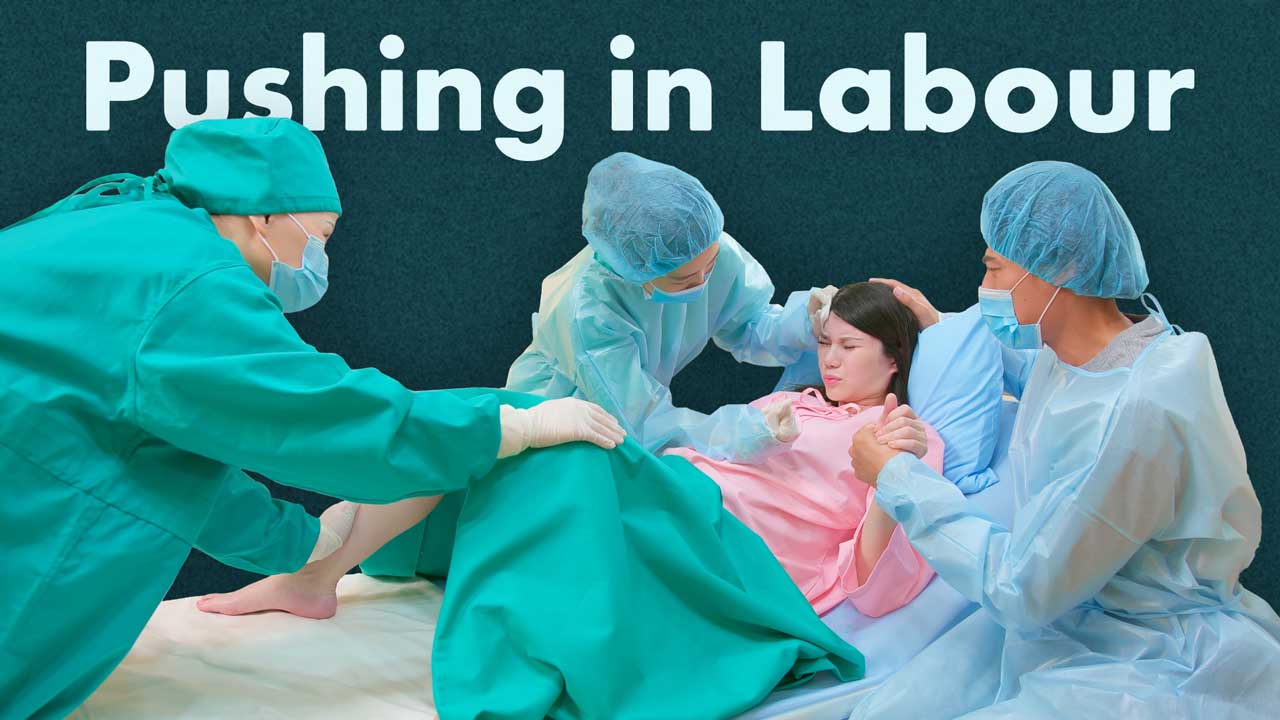Pushing Methods For the Second Stage of Labour
There are two approaches to pushing in the second stage of labour. Historically, directed pushing, also known as the Valsalva manoeuvre, has been favoured. It involves encouraging patients to take a deep breath at the beginning of a contraction, hold it and bear down throughout the contraction.
Conversely, spontaneous pushing allows patients to follow their own instincts and generally push three to five times per contraction.
Directed Pushing
The Valsalva method of pushing was first introduced in the 1950s and involves the patient taking a deep breath and forcefully pushing throughout a contraction.
However, this can increase the risk of nerve and structural damage to the pelvic floor due to the sudden increase of abdominal pressure and rapid expansion of vagina and perineum (Ahmadi et al. 2017).
Directed pushing is also associated with the following disadvantages:
- Increased risk of perineal tears
- Reduced maternal oxygen levels
- Reduced maternal blood pressure
- Maternal exhaustion
- Increased tisk of requiring interventions such as episiotomy, assisted delivery or caesarean birth
- Fetal distress
- Risk of urinary incontinence following birth.
(McCulloch 2023)
Neonatal wellbeing can be compromised by prolonged directed pushing. As Antsaklis et al. (2020) explain, when forceful pushing lasts for over six seconds, maternal haemodynamic measurements are altered. This results in inhibited venous return to the heart along with decreased cardiac output and lowered blood pressure, which in turn decrease placental blood perfusion. Ultimately, this can lead to reduced blood flow and oxygen to the fetus and a higher risk of poor fetal outcomes.
Spontaneous Pushing
A better approach based on current evidence is to delay pushing until the patient feels the urge to push. Not only does spontaneous pushing increase maternal satisfaction, but it also seems to be associated with fewer adverse outcomes (Cooper 2016).
Spontaneous pushing also has the key advantage of reducing tissue damage, as the perineal muscles are allowed to stretch slowly and steadily (Ahmadi et al. 2017).
There is also the benefit of evoking the Ferguson’s reflex, where oxytocin release is increased, labour is naturally augmented and bearing down efforts become more efficient and less stressful (Antsaklis et al. 2020).
Many researchers seem to agree that allowing the patient to follow their own instincts for how and when to push helps prevent perineal tears and therefore reduces the possibility of pelvic floor damage.
This is largely because spontaneous pushing allows for a slower and more controlled descent of the fetus, resulting in a gradual stretching of the perineal muscles. Pushing when an irresistible urge is present also reduces the pressure that is applied on the anterior vaginal wall, the cervical ligaments and the connective tissue supporting the vaginal walls, as pressure is not applied unless the fetus has already started to descend (Antsaklis et al. 2020).
Australian Recommendations
Australian guidelines advise against directed pushing and breath holding. Instead, patients should be encouraged to follow their own urge to push. This will typically involve pushing with an open glottis (SCV 2020; Queensland Health 2022).
Guidance may be provided if pushing is ineffective or the patient requests it. Other strategies that may be employed to assist birth include support, changing position or voiding the bladder (SCV 2020; Queensland Health 2022; Royal Hospital for Women 2020).
Patients should be discouraged from uncontrolled, explosive pushing as this can lead to perineal trauma (SCV 2020).
Conclusion
Current evidence no longer seems to support the practice of directed pushing, as it does not appear to confer any tangible benefits to either mother or infant. It can also have potentially negative effects on the anatomy of the labouring patient (Cooper 2020).
At this stage, the conclusion appears to be that it’s best for pushing to be guided by the patient and their own bodily instincts (Queensland Health 2022).
Topics
References
- Ahmadi, Z, Torkzahrani, S, Roosta, F, Shakeri, N & Mhmoodi Z 2017, ‘Effect of Breathing Technique of Blowing on the Extent of Damage to the Perineum at the Moment of Delivery: A Randomized Clinical Trial’, Iran J Nurs Midwifery Res., vol. 22, no. 1, viewed 14 July 2023, https://www.ncbi.nlm.nih.gov/pmc/articles/PMC5364755/
- Antsaklis, P, Papamichail, M, Theodora, M, Syndos, M, Daskalakis, G & Loutradis, D 2020, 'Natural Methods to Assist Delivery during the Second Stage of Labour: Part II: Timing and Type of Pushing', HJOG, vol. 19 no. 1, viewed 14 July 2023, http://hjog.org/wp-content/pdf/2020/01_Antsaklis.pdf
- Cooper, K 2016, ‘Exploring The Effects Of Second Stage Management From The Maternal And Midwifery Perspectives: Are There Any Benefits To Directing Women?’, MIDIRS Midwifery Digest, vol. 26, no. 2, viewed 14 July 2023, http://insight.cumbria.ac.uk/id/eprint/2363/
- McCulloch, S 2023, ‘Purple Pushing / Directed Pushing – Why Avoid It?’, BabyBelly, 4 July, viewed 14 July 2023, https://www.bellybelly.com.au/birth/purple-pushing-directed-pushing/
- Queensland Health 2022, Maternity and Neonatal Clinical Guideline: Normal Birth, Queensland Government, viewed 14 July 2023, https://www.health.qld.gov.au/__data/assets/pdf_file/0014/142007/g-normalbirth.pdf
- Royal Hospital for Women 2020, Second Stage of Labour - Recognition of Normal Progress and Management of Delay, New South Wales Government, https://www.seslhd.health.nsw.gov.au/sites/default/files/documents/secondstage2020.pdf
- Safer Care Victoria 2020, Care During Labour and Birth, Victoria State Government, viewed 14 July 2023, https://www.safercare.vic.gov.au/clinical-guidance/maternity/care-during-labour-and-birth
 New
New 
